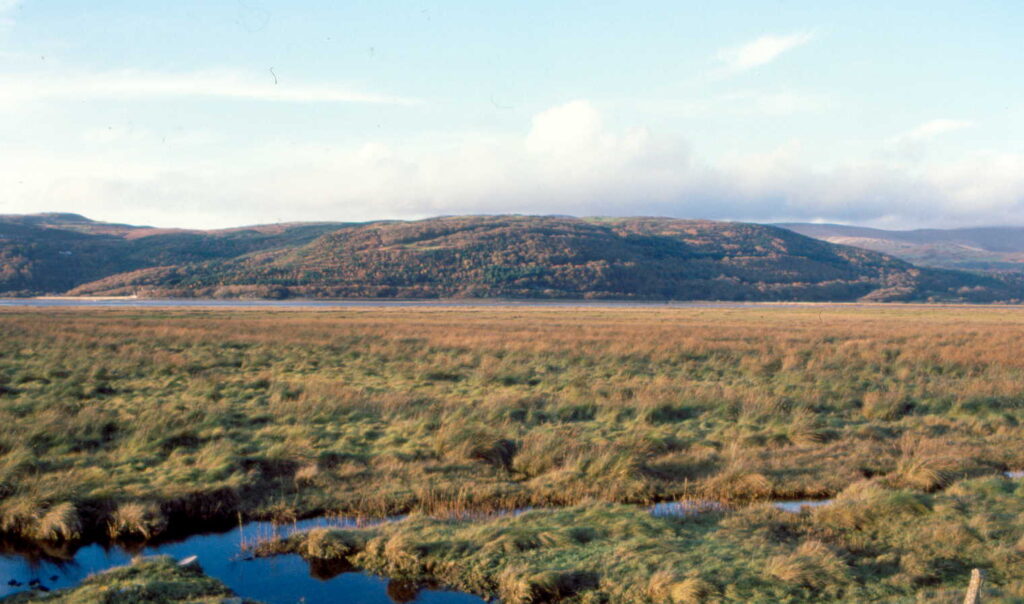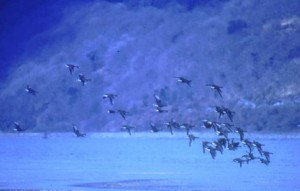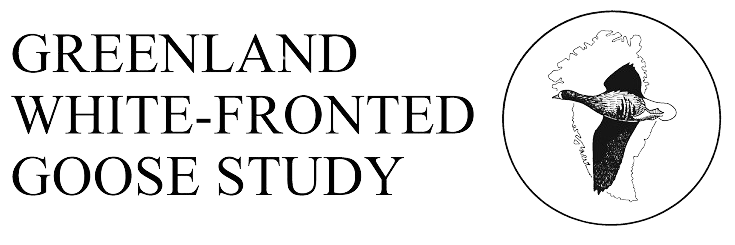
History
Forrest (1907) described the White-fronted Goose as common there, and Professor Salter knew them as regular winter visitors to the Dyfi Estuary. White-fronted Geese were apparently constantly present in the vicinity of the Dyfi Valley the years leading up to the Second World War, although not necessarily on the estuary or in the lowlands at that time. According to Salter’s diaries, he only encountered them in small groups of 2 to 20. There is no doubt that at that time, the geese frequently fed on upland bogs and lakes in north Ceredigion around the Dyfi, but it is not clear whether they used to fly to the estuary to roost. Salter frequently saw them upon Llyn Bygeilyn (SN821925) and Glaslyn (SN826941) to the east of the Dyfi as well as Llyn Craig-y-pistyll (SN721858), Pond Syfydrin (SN722847) and Cwmsymlog (SN708838) well to the south. Intriguingly, compared to these frequent records from the hill bogs and lakes, there were virtually no accounts of large numbers in his diaries from the Dyfi marshes where Salter spent considerable periods of time. In hard weather, the geese visited the coast from Aberaeron (SN46) to Towyn (SH50). The first written account of geese using the extensive area of raised mire on Cors Fochno does not appear until 3 May 1940, when he “saw evidence that there must have been a lot of wild geese here not long since”. Geese were frequently recorded feeding on Cors Fochno until the late 1970s, and during the period from the 1950s to 1970s, they clearly changed their behaviour and began roosting more and more on the intertidal flats of the estuary, and apparently spent an increasing period of time in the vicinity of the estuary feeding. Since 1968, regular wildfowl counts give a better picture of numbers and from 1971/2, Peter Davis recorded that the geese were spending more time feeding on the estuary during the day, especially the saltings at Ynyshir and saltmarsh near to the roost fringing “Wader Bay”. Geese also fed on subterranean Spartina shoots at this time as well. Even as late as 1975/6, geese were reported from hill mires to the south of the Dyfi, but since that years there have been very few sightings of the flock away from the estuary or adjacent farmland.

Status
National importance (R&O 61). Until recently, the most important site in Wales, now the only regular resort in the Principality, supporting between 90 and 130 geese in all recent years since 2000. This would seem a substantial reduction in numbers occurred between the early 1950s and the mid 1970s, but at that time there was a voluntary ban on hunting of White-fronted Geese on the Dyfi Estuary National Nature Reserve. Whether or not this was the cause of the recovery, numbers following that time increased to peak at 167 in 1999, although since that time the peak annual counts have declined as reflected at resorts elsewhere on the wintering grounds.
Maximum winter counts:
Breeding success: Assessment of breeding success has been regular and correlates with that on Islay throughout the period since 1982, albeit a little below that from Islay (see first diagram below). Being a relatively small flock, the difference between none, one and a few families in the flock makes a great deal of difference to the overall percentage of young birds, so there is greater fluctuation in the production than elsewhere (second diagram below). Therefore it is difficult to detect a strong trend of decline in the production in recent years compared to that in the 1980s and 1990s.
Feeding sites and habitat: The geese feed on inter-tidal saltmarsh, Spartina mud-flats and on quiet undisturbed reseeded grassland on and around the Dyfi Estuary. The flock very occasionally used the nearby Cors Fochno (Borth Bog) for feeding in the 1980s, but this was very rare compared with former times and seems to have totally ceased now. Large numbers of breeding Canada Geese now breed in and around Cors Fochno and in autumn uproot and consume Eriophorum angustifolium in the way once characteristic of only Greenland White-fronted Geese at the site.
Roosting sites: It is thought that the geese roost on the intertidal area of the estuary.
Habitat change: None known to affect the geese.
Aircraft disturbance: This was a problem in former times when there was a great deal of low flying up the estuary. However, given that this prevailed during the period of population increase it seems highly unlikely that this has a serious effect on the birds here.
Hunting disturbance: Although there is wildfowling on the estuary, there is still a voluntary ban on hunting of the species on the site, although currently a legal loophole means the race is without legislative protection from shooting here in Wales.
Agricultural disturbance: Not known, but highly unlikely to be a problem with this flock that feeds well away from farmland for most of the time.
Site safeguard: The geese feed and roost mainly within the Dyfi NCR SSSI which is part of Dyfi Estuary/Afon Dyfi SPA, a National Nature Reserve and includes Cors Fochno Ramsar Site and Ynyshir RSPB Reserve.
Threats: Geese feed primarily within the NNR and RSPB reserve which, together with international designation of the area, means that their habitats are relatively well protected. However, the geese do not have statutory protection and are dependent on a voluntary shooting ban self-imposed by the local wildfowling clubs. Numbers of sedentary feral Canada Geese have shown dramatic increases in recent years; these feed in the same habitats during winter and could pose competitive interaction problems in the future.
Linkages with other sites: One collared bird, 3XH, captured at Wexford in November 1990, spent the winter of 1991/92 on the Dyfi, was seen on Kintyre in autumn 1992 and was on Coll in 1993/4 before returning to Wexford in 1996/7. C0X was ringed at Wexford in 1993/4 and wintered on the Dyfi in winter 1994/5, but was back at Wexford in 1995/6-1997/8. F2L was ringed at Wexford in winter 1995/6, but shifted to winter on Islay in 1996/7 up until 19th December 1996 before appearing on the Dyfi on 8th February 1997; such changes within a winter are relatively unusual unless associated with spring or autumn staging on migrations. F2L was back at Wexford in 1999/2000, 2000/1 and 2001/2. H0A was ringed at Hvanneyri in western Iceland in spring 1997, it wintered at Appin, Benderloch in 1997/8, Wexford in 1998/9 and 1999/2000, but it was not seen in 2000/1, turned up on the Dyfi in November 2001 but was back at Wexford on 30th January 2002. H8C was caught at Hvanneyri in spring 1999, wintered at Wexford 1999/2000 and the Dyfi in 2000/1, but was back at Wexford in 2001/2 and in subsequent years.
References
Fox, A.D. & Stroud, D.A. (1986) The Greenland White-fronted Goose in Wales. Nature in Wales n.s. 4: 20-27.
Forrest, H.E. (1907) The Vertebrate Fauna of North Wales. Witherby, London.
